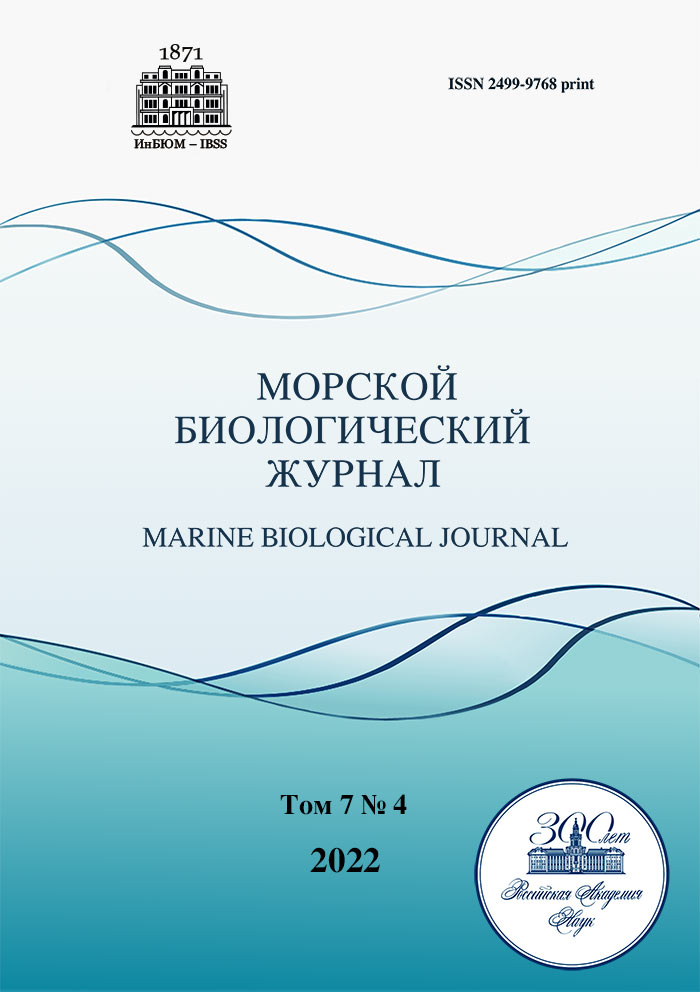Investigation of the long-wavelength threshold of spectral sensitivity in the gray seal Halichoerus grypus (Fabricius, 1791)
##plugins.themes.ibsscustom.article.main##
##plugins.themes.ibsscustom.article.details##
Abstract
In marine mammals, the absorption maxima of photopigments have a shift to the shorter-wavelength spectrum area compared to terrestrial mammals; this leads to a shift in the long-wavelength threshold of spectral sensitivity as well. In most publications focused on the investigation of long-wavelength sensitivity of marine mammals, only the absorption maxima of “red-sensitive” photopigments are given, but no data on maximum wavelengths of light emission that animals are able to perceive are provided. Therefore, this work was aimed at studying the long-wavelength thresholds of spectral sensitivity in a typical representative of earless seals – the gray seal Halichoerus grypus (Fabricius, 1791). During the experiment, a group of four gray seals was trained to press one of two buttons if a LED lamp located above it is switched on. In the lamp, there were groups of LEDs emitting monochromatic light in the wavelength range from 600 to 700 nm with a step of 10 nm and a luminous intensity of 0.5 cd. As shown, the lower perception threshold of light emission for the studied gray seals is light emission with a wavelength of 660 nm, and this confirms the data on the short-wavelength shift of the sensitivity peaks of photopigments in marine mammals. During prolonged exposure to extremely low-light conditions typical for the polar night, the long-wavelength perception threshold in the gray seals can increase from 660 to 670–680 nm.
Authors
References
Литвинов Ю. В., Пахомов М. В. Исследование способности серых тюленей дифференцировать сложносоставные звуковые сигналы // Вестник Мурманского государственного технического университета. 2019. Т. 22, № 2. С. 249–257. [Litvinov Yu. V., Pakhomov M. V. Investigation of the ability of gray seals to differentiate composite audio signals. Vestnik Murmanskogo gosudarstvennogo tekhnicheskogo universiteta, 2019, vol. 22, no. 2, pp. 249–257. (in Russ.)]. https://doi.org/10.21443/1560-9278-2019-22-2-249-257
Пахомов М. В. Исследование способности серых тюленей дифференцировать источники света с разными длинами волн // Труды Кольского научного центра РАН. 2020. Т. 11, № 5. С. 125–132. (Океанология ; вып. 8). [Pakhomov M. V. Research on the ability of gray seals to differentiate light sources with different wavelengths. Trudy Kol’skogo nauchnogo tsentra RAN, 2020, vol. 11, no. 5, pp. 125–132. (Okeanologiya ; iss. 8). (in Russ.)]. https://doi.org/10.37614/2307-5252.2020.11.5.014
Ala-Laurila P., Donner K., Koskelainen A. Thermal activation and photoactivation of visual pigments. Biophysical Journal, 2004, vol. 86, iss. 6, pp. 3653–3662. https://doi.org/10.1529/biophysj.103.035626
Bischoff N., Nickle B., Cronin T. W., Velasquez S., Fasick J. I. Deep-sea and pelagic rod visual pigments identified in the mysticete whales. Visual Neuroscience, 2012, vol. 29, iss. 2, pp. 95–103. https://doi.org/10.1017/S0952523812000107
Braekevelt C. R. Retinal epithelial fine structure in the grey seal (Halichoerus grypus). Acta Anatomica, 1986, vol. 127, no. 4, pp. 4255–4261. https://doi.org/10.1159/000146295
Fasick J. I., Robinson P. R. Spectral-tuning mechanisms of marine mammal rhodopsins and correlations with foraging depth. Visual Neuroscience, 2000, vol. 17, iss. 5, pp. 781–788. https://doi.org/10.1017/S095252380017511X
Gerard C. J., Mackay H. A., Thompson B., McIlvane W. J. Rapid generation of balanced trial distributions for discrimination learning procedures: A technical note. Journal of the Experimental Analysis of Behavior, 2014, vol. 101, iss. 1, pp. 171–178. https://doi.org/10.1002/jeab.58
Griebel U., König G., Schmid F. Spectral sensitivity in two species of pinnipeds (Phoca vitulina and Otaria flavescens). Marine Mammal Science, 2006, vol. 22, iss. 1, pp. 156–166. https://doi.org/10.1111/j.1748-7692.2006.00010.x
Hanke F. D., Hanke W., Scholtyssek C., Dehnhardt G. Basic mechanisms in pinniped vision. Experimental Brain Research, 2009, vol. 199, pp. 299–311. https://doi.org/10.1007/s00221-009-1793-6
Kirk A. P. Chapter 2 – From nuclear fusion to sunlight. In: Kirk A. P. Solar Photovoltaic Cells. Amsterdam ; Boston ; London : Academic Press, 2015, pp. 9–24. https://doi.org/10.1016/B978-0-12-802329-7.00002-X
Lamb T. D. Photoreceptor spectral sensitivities: Common shape in the long-wavelength region. Vision Research, 1995, vol. 3, iss. 22, pp. 3083–3091. https://doi.org/10.1016/0042-6989(95)00114-F
Lavigne D. M., Ronald K. The harp seal, Pagophilus groenlandicus (Erxleben 1777). XXIII. Spectral sensitivity. Canadian Journal of Zoology, 1972, vol. 50, no. 9, pp. 1197–1206. https://doi.org/10.1139/z72-161
Levenson D. H., Ponganis P. J., Crognale M. A., Deegan J. F., Dizon A., Jacobs G. H. Visual pigments of marine carnivores: Pinnipeds, polar bear, and sea otter. Journal of Comparative Physiology A, 2006, vol. 192, pp. 833–843. https://doi.org/10.1007/s00359-006-0121-x
Lewis P. R. A theoretical interpretation of spectral sensitivity curves at long wavelengths. Journal of Physiology, 1955, vol. 130, iss. 1, pp. 45–52. https://doi.org/10.1113/jphysiol.1955.sp005391
McFarland W. N. Cetacean visual pigments. Vision Research, 1971, vol. 11, iss. 10, pp. 1065–1076. https://doi.org/10.1016/0042-6989(71)90113-1
Palczewska G., Vinberg F., Stremplewski P., Bircher M. P., Salom D., Komar K., Zhang J., Cascella M., Wojtkowski M., Kefalov V. J., Palczewski K. Human infrared vision is triggered by two-photon chromophore isomerization. Proceedings of the National Academy of Sciences of the United States of America, 2014, vol. 111, no. 50, pp. E5445–E5454. https://doi.org/10.1073/pnas.1410162111
Peichl L., Behrmann G., Kröger R. H. For whales and seals the ocean is not blue: A visual pigment loss in marine mammals. European Journal of Neuroscience, 2001, vol. 13, iss. 8, pp. 1520–1528. https://doi.org/10.1046/j.0953-816x.2001.01533.x
Sliney D. H., Wangemann R. T., Franks J. K., Wolbarsht M. L. Visual sensitivity of the eye to infrared laser radiation. Journal of the Optical Society of America, 1976, vol. 66, iss. 4, pp. 339–341. https://doi.org/10.1364/josa.66.000339
Sliney D. H. Exposure geometry and spectral environment determine photobiological effects on the human eye. Photochemistry and Photobiology, 2005, vol. 81, no. 3, pp. 483–489.
Sliney D. H. What is light? The visible spectrum and beyond. Eye, 2016, vol. 30, no. 2, pp. 222–231. https://doi.org/10.1038/eye.2015.252


 Google Scholar
Google Scholar



